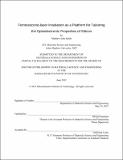Femtosecond-laser irradiation as a platform for tailoring the optoelectronic properties of silicon
Author(s)
Smith, Matthew John, Ph. D. Massachusetts Institute of Technology
DownloadFull printable version (12.72Mb)
Alternative title
Fs laser irradiation as a platform for tailoring the optoelectronic properties of silicon
Other Contributors
Massachusetts Institute of Technology. Dept. of Materials Science and Engineering.
Advisor
Silvija Gradečak.
Terms of use
Metadata
Show full item recordAbstract
Silicon is the most abundant semiconductor on earth and benefits from decades of technological development driven by the integrated circuit industry. Furthermore, silicon allows for facile n-type and p-type doping, has a naturally passivating surface oxide, and long minority carrier lifetimes. The major drawback of silicon is that it has an indirect band gap at 1.1 eV. It is therefore a poor light absorber and is naturally transparent to light in the infrared. Femtosecond (fs) laser irradiation offers multiple unique approaches to improving the optoelectronic properties of silicon, enabling both thin-film silicon photovoltaics and silicon-based IR photodetectors. In this thesis I study the structure-property-processing relationships related to the fs-laser irradiation of silicon in the context of both surface texturing and optical hyperdoping. Fs-laser surface texturing enables the use of thinner silicon wafers through efficient light trapping at the surface, but laser induced damage can degrade the performance of optoelectronic devices. The first part of this thesis investigates the relevant mechanisms of plastic deformation during surface texturing with fs-laser irradiation. Through a combination of Raman spectroscopy and TEM, I show that pressure-induced silicon polymorphs (amorphous silicon, Si-XII, Si-III) form beneath the surface during fs-laser irradiation. Combining characterization of the surface morphology using scanning electron microscopy, Raman investigations of the formation of Si- XII and Si-III, and TEM investigations of the spatial distribution of the amorphous silicon, we report that pressure-induced phase transformations are closely coupled to micron-scale surface texturing. Next, I identify the pressure generation mechanisms responsible for the pressure-induced phase transformations through a systematic investigation into the relationship between irradiation conditions and silicon polymorphs formation. Beginning with the observation that rastering the Gaussian laser beam drastically increases the amount of Si-XII formed, I use Raman spectroscopy to investigate silicon polymorph formation and residual lattice strains following irradiation at constant fluence and irradiation under modulated fluence. A strong increase in Si- XII formation is reported in laser spots that received a combination of high-fluence and lowfluence irradiation, as is generated by rastering the Gaussian laser beam across the surface. TEM investigations confirm that low-fluence irradiation increases the melt depth and that the spatial distribution of silicon polymorphs is correlated with melting and resolidification on roughened surfaces. Based on these investigations, it is concluded that resolidification-induced stresses are responsible for the observed pressure-induced plastic deformation. Optical hyperdoping, the subject of the second half of this thesis, refers to the use of pulsed laser irradiation to drive supersaturated concentrations of dopants into a semiconductor. Fs-laser hyperdoping of silicon with chalcogens has been shown to extend the responsivity of silicon photodiodes into the near-infrared and increase absorption in the visible and infrared. First, hyperdoping from a thin-film dopant precursor is investigated through the comparative structural (SEM and TEM), electronic (p-n diode formation), and optical (UV-VIS-NIR spectrophotometry) characterization of silicon irradiated with fs-laser pulses following the deposition of a selenium thin film on the surface, silicon irradiated in the presence of a gaseous dopant precursor, and silicon irradiated without dopant present. The use of a thin-film dopant precursor is found to have significant consequences on the resulting microstructure and dopant distribution compared to fs-laser doping from a gaseous precursor; producing large, discontinuous volumes of polycrystalline hyperdoped material. The observed microstructure and dopant distribution can account for the increased sub-band gap absorptance and poor diode rectification exhibited by thin-film hyperdoped surfaces. Next, advanced structural investigations into the selenium distribution with annealing show significant selenium segregation and precipitation. With this information, previous investigations into the optical deactivation of selenium with annealing are revisited and shown to be consistent with a kinetic model for optical deactivation by precipitation. To improve the dopant distribution achieved by thin-film fs-laser doping, the dopant incorporation process is elucidated by monitoring the surface structure (SEM) and dopant distribution (TEM) with variedMJS laser fluence and number of laser pulses. From very early stages of irradiation, the crystallization of hyperdoped material is found to be closely coupled to the surface structuring process, likely due to the effects that surface roughness has on local energy deposition and heat dissipation. The large, polycrystalline peaks are shown to form through a novel regime of crystallization-driven growth, which transitions into ablationdominated surface structuring after many laser pulses. Finally, the suppression of localized recrystallization is achieved by irradiation with many pulses (100) at very low fluences (1.2-1.4 kJ/m2), resulting in a thin, continuous layer of hyperdoped material. The investigations presented in this thesis present progress towards controllable and optimized implementation of fs-laser irradiation as a platform for improving the optoelectronic properties of silicon through both surface texturing and optical hyperdoping.
Description
Thesis (Ph. D.)--Massachusetts Institute of Technology, Dept. of Materials Science and Engineering, 2012. This electronic version was submitted by the student author. The certified thesis is available in the Institute Archives and Special Collections. Cataloged from student submitted PDF version of thesis. Includes bibliographical references (p. 169-176).
Date issued
2012Department
Massachusetts Institute of Technology. Department of Materials Science and EngineeringPublisher
Massachusetts Institute of Technology
Keywords
Materials Science and Engineering.